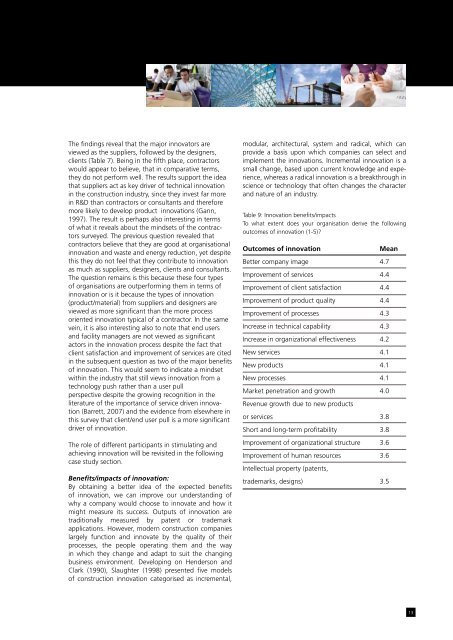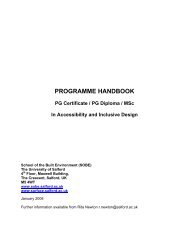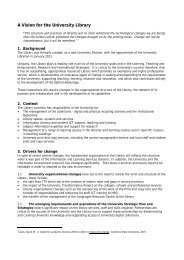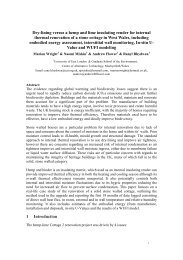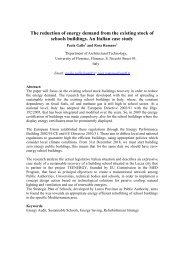Innovation in Construction A Project Life Cycle Approach
Innovation in Construction A Project Life Cycle Approach
Innovation in Construction A Project Life Cycle Approach
Create successful ePaper yourself
Turn your PDF publications into a flip-book with our unique Google optimized e-Paper software.
The f<strong>in</strong>d<strong>in</strong>gs reveal that the major <strong>in</strong>novators areviewed as the suppliers, followed by the designers,clients (Table 7). Be<strong>in</strong>g <strong>in</strong> the fifth place, contractorswould appear to believe, that <strong>in</strong> comparative terms,they do not perform well. The results support the ideathat suppliers act as key driver of technical <strong>in</strong>novation<strong>in</strong> the construction <strong>in</strong>dustry, s<strong>in</strong>ce they <strong>in</strong>vest far more<strong>in</strong> R&D than contractors or consultants and thereforemore likely to develop product <strong>in</strong>novations (Gann,1997). The result is perhaps also <strong>in</strong>terest<strong>in</strong>g <strong>in</strong> termsof what it reveals about the m<strong>in</strong>dsets of the contractorssurveyed. The previous question revealed thatcontractors believe that they are good at organisational<strong>in</strong>novation and waste and energy reduction, yet despitethis they do not feel that they contribute to <strong>in</strong>novationas much as suppliers, designers, clients and consultants.The question rema<strong>in</strong>s is this because these four typesof organisations are outperform<strong>in</strong>g them <strong>in</strong> terms of<strong>in</strong>novation or is it because the types of <strong>in</strong>novation(product/material) from suppliers and designers areviewed as more significant than the more processoriented <strong>in</strong>novation typical of a contractor. In the sameve<strong>in</strong>, it is also <strong>in</strong>terest<strong>in</strong>g also to note that end usersand facility managers are not viewed as significantactors <strong>in</strong> the <strong>in</strong>novation process despite the fact thatclient satisfaction and improvement of services are cited<strong>in</strong> the subsequent question as two of the major benefitsof <strong>in</strong>novation. This would seem to <strong>in</strong>dicate a m<strong>in</strong>dsetwith<strong>in</strong> the <strong>in</strong>dustry that still views <strong>in</strong>novation from atechnology push rather than a user pullperspective despite the grow<strong>in</strong>g recognition <strong>in</strong> theliterature of the importance of service driven <strong>in</strong>novation(Barrett, 2007) and the evidence from elsewhere <strong>in</strong>this survey that client/end user pull is a more significantdriver of <strong>in</strong>novation.The role of different participants <strong>in</strong> stimulat<strong>in</strong>g andachiev<strong>in</strong>g <strong>in</strong>novation will be revisited <strong>in</strong> the follow<strong>in</strong>gcase study section.Benefits/impacts of <strong>in</strong>novation:By obta<strong>in</strong><strong>in</strong>g a better idea of the expected benefitsof <strong>in</strong>novation, we can improve our understand<strong>in</strong>g ofwhy a company would choose to <strong>in</strong>novate and how itmight measure its success. Outputs of <strong>in</strong>novation aretraditionally measured by patent or trademarkapplications. However, modern construction companieslargely function and <strong>in</strong>novate by the quality of theirprocesses, the people operat<strong>in</strong>g them and the way<strong>in</strong> which they change and adapt to suit the chang<strong>in</strong>gbus<strong>in</strong>ess environment. Develop<strong>in</strong>g on Henderson andClark (1990), Slaughter (1998) presented five modelsof construction <strong>in</strong>novation categorised as <strong>in</strong>cremental,modular, architectural, system and radical, which canprovide a basis upon which companies can select andimplement the <strong>in</strong>novations. Incremental <strong>in</strong>novation is asmall change, based upon current knowledge and experience,whereas a radical <strong>in</strong>novation is a breakthrough <strong>in</strong>science or technology that often changes the characterand nature of an <strong>in</strong>dustry.Table 9: <strong>Innovation</strong> benefits/impactsTo what extent does your organisation derive the follow<strong>in</strong>goutcomes of <strong>in</strong>novation (1-5)?Outcomes of <strong>in</strong>novationMeanBetter company image 4.7Improvement of services 4.4Improvement of client satisfaction 4.4Improvement of product quality 4.4Improvement of processes 4.3Increase <strong>in</strong> technical capability 4.3Increase <strong>in</strong> organizational effectiveness 4.2New services 4.1New products 4.1New processes 4.1Market penetration and growth 4.0Revenue growth due to new productsor services 3.8Short and long-term profitability 3.8Improvement of organizational structure 3.6Improvement of human resources 3.6Intellectual property (patents,trademarks, designs) 3.513


